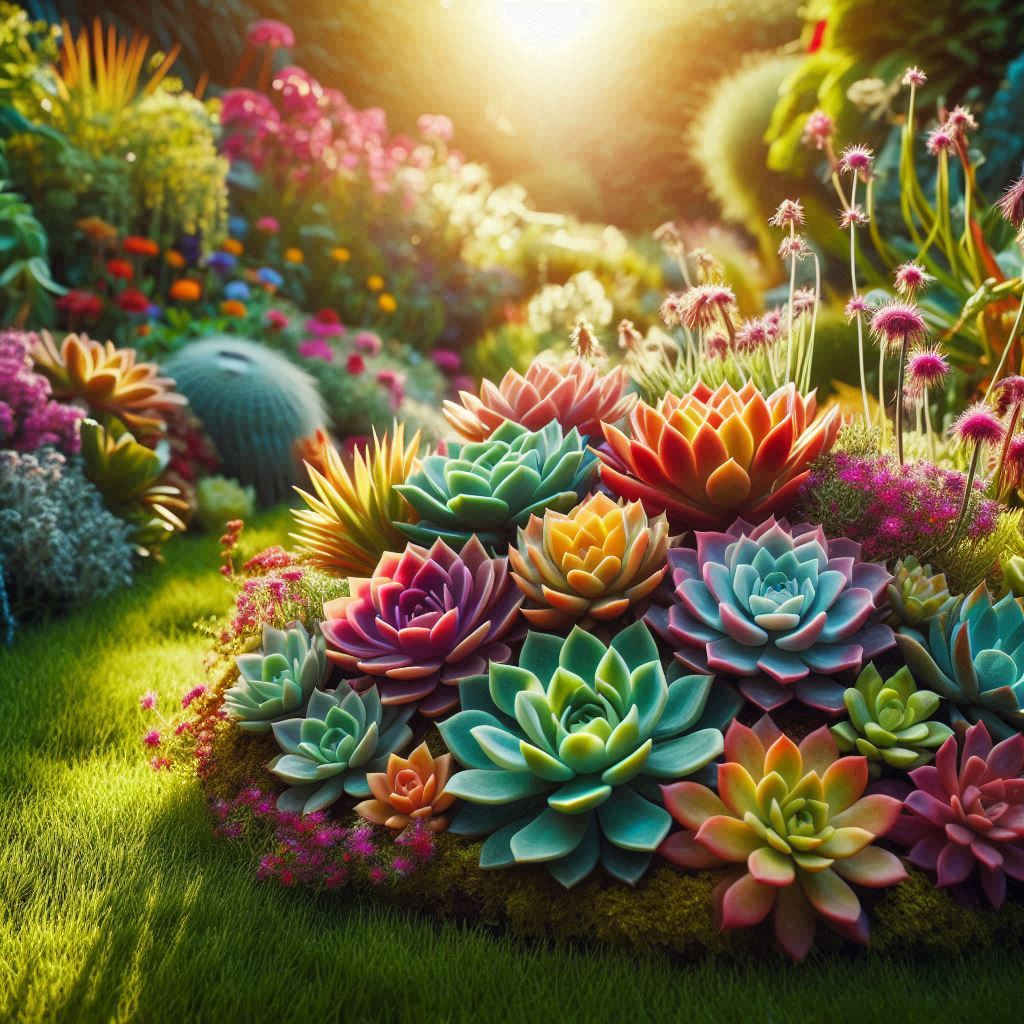How long can succulents live? This is a question many plant enthusiasts wonder about. Succulents are known for their resilience and unique beauty. With the right care, these fascinating plants can live for many years. In this post, we will explore various factors that affect the lifespan of succulents, offering you tips to keep them healthy and thriving. You’ll learn about the impact of environment, care practices, and common pitfalls to avoid to ensure your succulents live a long, vibrant life.
Understanding the Lifespan of Different Succulent Species
Succulents are renowned for their hardiness and ability to thrive in challenging conditions. Yet, did you know that their lifespans can vastly differ depending on the species? Understanding each plant’s potential longevity is essential to becoming an effective succulent caretaker.
Echeveria species, for example, are popular among succulent enthusiasts and generally exhibit a lifespan of around six to eight years. However, with optimal care, they can last even longer. Prone to developing long, droopy stems if not pruned regularly, maintaining their health and form requires consistent attention.
Aeoniums, with their unique rosette shapes, have a shorter lifespan, usually living around three to five years. They often go into dormancy, making them less forgiving of overwatering during this period. Ensuring well-draining soil and light exposure can extend their life.
Then there’s the resilient Haworthia, a succulent known for its ability to live a long life, sometimes reaching up to 25 years. The secret to their longevity lies within their adaptability; they flourish in both indoor and outdoor environments if not subjected to direct, relentless sunlight.
Finally, the classic Jade Plant can astound with a potential lifespan of 50 to even 70 years in the right conditions. Often treated as a family heirloom, these plants symbolize good luck and enduring relationships. Proper watering schedules and pruning are crucial to prevent root rot and ensure their longevity.
Understanding these key lifespan differences among succulent species not only helps in choosing the right plant for your lifestyle but also prolongs their aesthetic presence in your home or garden. Always take note of each plant’s specific needs, whether it’s sunlight, water, or soil, as these factors significantly contribute to their lifespan. Ultimately, gardening with succulents is about adapting to these variables to maximize their longevity and beauty.
Factors That Determine How Long Succulents Can Live
Succulents are known for their resilience, but many factors can influence how long they actually live. One of the primary elements that affect their lifespan is the species of the succulent. Different species have innate lifespans; some can live for just a few years, while others may thrive for decades.
Another key factor is environmental conditions. Succulents generally thrive in warm environments with low humidity; however, exposure to extreme temperatures or sudden shifts can shorten their lifespan. The soil quality and drainage also play a significant role. Succulents require well-draining soil to prevent root rot, which can lead to premature death.
Watering practices contribute significantly as well. Overwatering is a common issue, as succulents need less water than most plants. Correct watering techniques—allowing the soil to dry completely between waterings—are crucial in maintaining healthy succulents. Additionally, light exposure affects their longevity since succulents need sufficient sunlight to perform photosynthesis effectively, but too much direct sunlight can cause sunburn.
Proper care and regular maintenance, such as pruning and fertilization, can also impact a succulent’s lifespan by encouraging new growth and preventing diseases. Taking note of these factors can ensure your succulents lead long, healthy lives.
Indoor vs. Outdoor Succulent Lifespans: What to Expect
Succulents can thrive in both indoor and outdoor settings, each offering its unique benefits and challenges. The lifespan of a succulent significantly varies based on where it resides. Indoor succulents often enjoy a more stable environment, protected from harsh weather conditions, pests, and extreme temperature fluctuations. However, they may lack essential sunlight, crucial for their photosynthesis process. Outdoor succulents, on the other hand, benefit from direct sunlight and natural air circulation, which can promote healthy and robust growth.
Despite these advantages, outdoor succulents are exposed to unpredictable weather conditions like frost, heavy rain, or extreme heat, which can potentially shorten their lifespan. Therefore, providing the right balance of care, such as partial shading or shelter during adverse weather, becomes imperative for outdoor settings.
Whether your succulent resides inside or outside, its longevity also depends on factors like soil quality, watering habits, and container drainage. Well-draining soil and pots with drainage holes are crucial to prevent root rot, a common issue that can dramatically impact a succulent’s health.Indoor environments may require controlled watering schedules, while outdoor succulents might need adjustments based on seasonal changes. Understanding these dynamics can help you anticipate what to expect in terms of your succulent’s lifespan.
Ultimately, providing optimal conditions tailored to the specific environment will ensure that your succulents not only survive but thrive, rewarding you with their remarkable longevity.
How Proper Care Can Extend the Lifespan of Succulents
Succulents are known for their resilience and ability to thrive in various environments, but their longevity is significantly impacted by proper care. Implementing the right techniques can help your succulents not only survive but thrive over the years. Ensuring that your succulents get the proper amount of sunlight is crucial. While they love light, too much direct sunlight can scorch their leaves. Aim for a balance that provides adequate light without risk of damage.
Watering is another key factor. Succulents need well-draining soil and should not be overwatered. Allow the soil to dry out completely between waterings to avoid root rot, which is a common issue when caring for these plants. Additionally, the choice of soil can make a big difference. A cactus mix or a homemade soil consisting of sand, perlite, and a bit of regular potting soil works well.
Furthermore, temperature and climate play vital roles. Most succulents prefer warm temperatures and do not fare well in extreme cold. If you’re growing succulents in a region with severe winters, consider keeping them indoors during those months. Regular pruning, removing dead or dying leaves, and pest control are also important in extending their lifespan.
Finally, the importance of fertilization can’t be overlooked. Utilize a balanced, diluted fertilizer during the growing season to provide the nutrients your succulents need to grow strong and healthy without overloading them.
How Succulent Lifespan Varies Across Different Environments
Succulents thrive under a range of environmental conditions, and the lifespan of these resilient plants can vary significantly depending on where they are placed. Various factors such as light exposure, temperature, humidity levels, and soil composition play crucial roles in determining how long succulents live. Understanding these elements can help succulent enthusiasts optimize care and maximize plant longevity.
Desert Environments: In their natural habitat, succulents, like cacti and agaves, can thrive for decades or even centuries. The arid conditions with little rainfall, abundant sunlight, and well-draining sandy soils make deserts ideal for these plants. The extreme weather conditions compel succulents to develop robust mechanisms for water storage and conservation, significantly prolonging their lifespan.

Indoor Settings: Indoors, succulents face a different set of challenges. Limited sunlight, dry air from heating systems, and inconsistent watering can stress these plants, potentially shortening their lifespan. However, with proper light positioning and a consistent care routine, indoor succulents can still flourish for many years.
Coastal Regions: In coastal areas, succulents may have a shorter lifespan due to high humidity levels, salt exposure, and frequent rainfalls. Not all succulents can tolerate the moist conditions, which can lead to root rot if the soil does not drain well. Selecting species like aeoniums or certain echeverias, which adapt better to these conditions, can provide better results.
Greenhouses: Controlled environments like greenhouses offer succulent plants the best of both worlds. Ideal temperature, humidity control, and protection from pests enable succulents to have prolonged lifespans. Gardeners in greenhouses can also simulate natural drought periods followed by soaking rains, mimicking natural habitat conditions.
Common Signs of Aging in Succulents
Succulents show clear signs of aging that might not always be obvious to the untrained eye. Pale and discolored leaves are one of the first indicators, as aging succulents may lose the vibrant green hues they once had. You might also notice wrinkles or shriveling on the leaves, a telltale that the plant is struggling to retain moisture due to age.
Another common sign is the wilting of the lower leaves. As the plant ages, it will often shed its older leaves in favor of nurturing new growth. Pay attention to any browning or crispiness at the edges of leaves, as this can suggest age-related stress or environmental issues impacting your plant.
Succulent stems might become longer and wooden over time, especially if the plant is seeking more light. This is known as ‘etiolation’ and is a classic sign of an aging plant adapting to its environment. Keep an eye out for root bound issues too; older succulents might outgrow their containers, making it necessary to consider repotting them.
The plant’s growth rate may slow down significantly due to age. Mature succulents tend to focus their energy on stability rather than the vigorous growth seen in younger plants. Recognizing these signs can help you understand and care for your succulents better as they age.
Propagation: A Strategy to Keep Your Succulents Growing Indefinitely
Propagation is a fascinating strategy for ensuring your succulents continue thriving indefinitely. By propagating, you create new plants from the original, effectively bypassing their natural lifespan constraints. This method isn’t just for seasoned gardeners—anyone can master it with a bit of practice!
Start with Leaf Cuttings: To propagate succulents, begin by selecting healthy leaves. Gently twist the leaf off the stem, ensuring you get the entire leaf to maximize your success rates. Allow the leaf to dry out and callous over, preventing rot when placed on the soil.
Soil and Water: Nestle your calloused leaf on a bed of well-draining soil, misting occasionally to provide moisture without waterlogging. As roots develop, you will notice small succulents emerging at the base, ready for potting and nurture.
Propagation doesn’t just extend the life of your plants; it’s a budget-friendly way to grow your collection. Consider the environmental needs of your new succulents—ample sunlight and low humidity typically lead to robust growth.
Mastering propagation allows enthusiasts to perpetually cultivate these captivating plants, intertwining with their natural lifecycle for an endless display of greenery. Understanding how long succulents can live with this technique in your horticultural toolkit, you can explore the vast diversity of succulent species, experimenting with new varieties while preserving the beauty of those you already cherish.
Do Larger Succulents Live Longer Than Smaller Ones?
One may wonder whether the size of a succulent influences its longevity. While size can be an indicator of age, larger succulents do not necessarily outlive their smaller counterparts. The lifespan of a succulent is primarily dictated by its species and care rather than its size.
Nurturing Small and Large Succulents: Both large and small succulents require meticulous care to thrive. Ensuring adequate sunlight, appropriate watering, and suitable soil is essential for their survival.
Succulents such as Aeonium or Aloe may grow significantly larger than others like Echeveria or Haworthia, but this doesn’t necessarily imply a longer life. The longevity of each species is influenced more by its inherent characteristics and the care it receives.
Monitoring Growth and Longevity: Regular inspection of both large and small succulents can help detect early signs of aging or distress. By understanding the individual growth patterns, enthusiasts can tailor their care practices to suit their specific needs, ensuring a long, healthy life for all their plants.
How to Revive an Aging Succulent: Tips and Tricks
Assess the Condition
Begin by closely examining the succulents’ leaves and stem. Look for common signs of aging such as yellowing leaves, wilting, or a weak stem. Use a gentle touch to determine if the leaves and stem are solid or mushy. This initial check will help decide the next course of action based on the succulent’s needs.
Optimize Sunlight and Placement
Succulents thrive with adequate sunlight but can suffer from too much direct heat, especially when they are aging. Gradually introduce an older succulent to brighter settings without direct sunlight. Aim for indirect light or morning sun for several hours each day to strengthen their growth.
Adjust Watering Routines
Adjust your watering schedule carefully. Older succulents often need less frequent watering than younger ones. Overwatering is a common cause of aging symptoms, so it’s crucial to let the soil dry out completely between waterings.
Repot with Fresh Soil
If the succulent is struggling, consider repotting it with fresh, well-draining succulent mix. This rejuvenates the plant by providing fresh nutrients and improving soil aeration. Select a pot that allows excess water to escape through drainage holes.
Remove Dead or Damaged Parts
Trim away any dead leaves or stems to encourage the growth of new healthy parts. Use clean scissors or pruning shears and cut as close to the base as feasible to avoid spreading disease.
Introduce a Balanced Fertilizer
An aging succulent might benefit from a balanced, diluted fertilizer. Apply it during the growing season when the succulent is not dormant, ensuring you follow the guidelines for concentration and frequency to avoid over-fertilization.
Monitor Temperature and Humidity
Older succulents can be sensitive to temperature fluctuation and humidity. Ensure they are placed in an area with stable temperatures and low humidity, suitable for their natural desert-like environment.
The Role of Soil and Watering in Succulent Longevity
Soil plays a crucial role in succulent health and longevity. Succulents thrive in well-draining soil, which prevents root rot and suffocation. Using a specialized cactus or succulent mix can greatly prolong their lifespan by ensuring adequate water drainage. The right composition typically includes a mix of sandy soil, perlite, or pumice to promote air circulation around the roots.
Watering is equally important and must be carefully regulated.
Over-watering
Is how long can succulents live affected by common mistakes that impact their lifespan negatively, leading to root rot and decay. Conversely, underwatering can cause the succulent to wither and the leaves to shrivel. To find the right balance, adopt a ‘soak and dry’ method—water the soil thoroughly, then allow it to dry completely before the next watering. This method emulates their natural desert environment and ensures the soil remains aerated.
Adjust your watering schedule according to the season and light conditions. During the growing seasons of spring and summer, succulents need more frequent watering. In the dormancy of fall and winter, they require less. By tailoring watering practices to the plant’s needs, we can ensure succulents live their longest and healthiest lives.
How Climate and Temperature Affect Succulent Lifespan
Climate and temperature play a crucial role in the overall lifespan of succulents. These resilient plants thrive in specific climates and may struggle in regions that deviate significantly from their native environment. Understanding their needs can help you cultivate robust succulents that enjoy long lives.
Temperature is a key factor that affects succulent health. Most succulents prefer warm conditions and are used to the temperatures found in arid or semi-arid environments. They thrive best in temperatures ranging from 60°F to 80°F (about 15°C to 27°C). When temperatures drop significantly below this range, succulents may become susceptible to damage, particularly in frost conditions.
Extreme Temperatures can be detrimental. Prolonged exposure to cold can cause cell damage, resulting in unsightly black marks or even the death of the plant. On the other hand, extremely high temperatures can cause the plant to dehydrate rapidly, leading to sunburn or desiccation.
The impact of climate extends beyond temperature. Humidity plays a significant role. Succulents generally prefer dry air and can develop issues such as rot if exposed to consistently high humidity. This is because excessive moisture in the air limits the plant’s ability to transpire, which can lead to waterlogged roots.
Adjustments in your local environment can help succulents adapt. For example, during colder months, it’s beneficial to move potted succulents inside or provide them with a protective cover. If you’re in a humid area, ensure adequate airflow around your plants and consider using gritty soil to facilitate better drainage.
Maximizing Succulent Longevity with Regular Pruning and Care
Implementing regular pruning and care strategies is crucial for enhancing the longevity of succulents. Pruning not only stimulates growth but also removes dead or damaged leaves, allowing the plant to channel its energy more effectively. When you prune succulents, it helps them maintain a desirable shape and prevents them from becoming leggy.
Begin by examining the brown and shriveled leaves at the base of the plant. Carefully remove these with clean, sharp scissors or pruning shears to prevent any potential disease from spreading. This practice ensures that the succulent receives adequate air circulation and sunlight, essential for its prolonged life.
Regular care includes occasional cleaning, ensuring that dust and debris do not accumulate on the leaves. Succulents thrive when their leaves are clean, as they maximize photosynthesis effectively. Additionally, assess the plant’s environment in terms of light and temperature. It’s important to ensure that it receives the appropriate amount of indirect sunlight, as excessive direct sunlight can cause sunburn.
Consistent watering practices also play a pivotal role. Allow the soil to dry out completely between waterings, mimicking their natural desert habitat. Overwatering should be avoided at all costs, as it leads to root rot, which can dramatically reduce a succulent’s lifespan. By incorporating these detailed and sustainable care practices, you ensure that your succulents not only survive but thrive for years to come, echoing the fascinating insights shared in ‘How Long Can Succulents Really Live? This Might Shock You!’
There is a vast variety of succulent species, each with unique characteristics. Aloe vera, renowned for its medicinal properties, typically thrives and can live for about 5 to 25 years under ideal conditions. On the other hand, some species like the Agave can reach up to several decades, culminating in a final flowering event before they die. Echeverias display vibrant, rosette shapes and usually have a lifespan of 3 to 7 years indoors, though they may last longer in optimal outdoor environments. So, how long can succulents live varies significantly based on the species and growing conditions.
Another long-lived favorite, the Jade Plant (Crassula ovata), can delight plant enthusiasts for many decades if cared for sufficiently.
Haworthias
, known for their striped leaves, usually fare well between 5 to 10 years. Each plant’s longevity is influenced by species-specific traits, such as growth rate and natural habitat. For enthusiasts looking to keep their succulents vibrant for as long as possible, understanding these lifespans can help tailor care techniques and expectations.
While some succulents bloom once, signaling life’s end like the Agave, others can live on by producing offshoots. Learning about the potential lifespan of each type can help you keep them thriving longer and enjoy the delightful array of forms and textures that these resilient plants offer.







